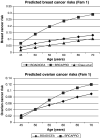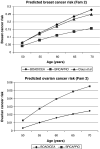The BOADICEA model of genetic susceptibility to breast and ovarian cancer
- PMID: 15381934
- PMCID: PMC2409934
- DOI: 10.1038/sj.bjc.6602175
The BOADICEA model of genetic susceptibility to breast and ovarian cancer
Abstract
Several genes conferring susceptibility to breast and ovarian cancer, notably BRCA1 and BRCA2, have been identified. The majority of the familial aggregation of breast cancer is, however, not explained by these genes. We have previously derived, using segregation analysis, a susceptibility model (BOADICEA, Breast and Ovarian Analysis of Disease Incidence and Carrier Estimation Algorithm) in which susceptibility to these genes is explained by mutations in BRCA1 and BRCA2 together with a polygenic component reflecting the joint multiplicative effect of multiple genes of small effect on breast cancer risk. Here, we consider the predictions made by this model. The overall familial risks of breast cancer predicted by this model are close to those observed in epidemiological studies. The predicted prevalences of BRCA1 and BRCA2 mutations among unselected cases of breast and ovarian cancer are also consistent with observations from population-based studies. These predictions are closer to the observed values than those obtained using the Claus model and BRCAPRO. The predicted mutation probabilities and cancer risks in individuals with a family history (FH) can differ markedly from those predicted by other models. We conclude that this model provides a rational basis for risk assessment in individuals with a FH of breast or ovarian cancer.
Figures






Comment in
-
Remarks on the BOADICEA model of genetic susceptibility to breast and ovarian cancer.Br J Cancer. 2005 Apr 11;92(7):1336-7; author reply 1337-8. doi: 10.1038/sj.bjc.6602489. Br J Cancer. 2005. PMID: 15785743 Free PMC article. No abstract available.
References
-
- Antoniou A, Pharoah PD, Narod S, Risch HA, Eyfjord JE, Hopper JL, Loman N, Olsson H, Johannsson O, Borg A, Pasini B, Radice P, Manoukian S, Eccles DM, Tang N, Olah E, Anton-Culver H, Warner E, Lubinski J, Gronwald J, Gorski B, Tulinius H, Thorlacius S, Eerola H, Nevanlinna H, Syrjakoski K, Kallioniemi OP, Thompson D, Evans C, Peto J, Lalloo F, Evans DG, Easton DF (2003) Average risks of breast and ovarian cancer associated with BRCA1 or BRCA2 mutations detected in case Series unselected for family history: a combined analysis of 22 studies. Am J Hum Genet 72: 1117–1130 - PMC - PubMed
-
- Antoniou AC, Pharoah PD, McMullan G, Day NE, Ponder BA, Easton D (2001) Evidence for further breast cancer susceptibility genes in addition to BRCA1 and BRCA2 in a population-based study. Genet Epidemiol 21: 1–18 - PubMed
-
- Apicella C, Andrews L, Hodgson SV, Fisher SA, Lewis CM, Solomon E, Tucker K, Friedlander M, Bankier A, Southey MC, Venter DJ, Hopper JL (2003) Log odds of carrying an ancestral mutation in BRCA1 or BRCA2 for a defined personal and family history in an Ashkenazi Jewish woman (LAMBDA). Breast Cancer Res 5: R206–R216 - PMC - PubMed
Publication types
MeSH terms
LinkOut - more resources
Full Text Sources
Other Literature Sources
Medical
Miscellaneous

